Introduction to Race and Ethnicity in the United States
Ron Hammond, Paul Cheney, Raewyn Pearsey
Why Do We Define Race The Way We Do?
Race is socially important yet biologically insignificant in the United States. A Racial Group is a group of people with perceived unique biological and physical characteristics. Race is and has been assumed for centuries as being biologically based and even biologically distinguishable between various groups (African Americans, Whites, Asians, and Native Americans). Science has proven this to be a myth— racial groups are NOT in fact biologically different in significant ways. Current conceptions of race originated long before genetics as a scientific discipline came to be. Here’s the simple scientifically based truth about biological differences between the races—there are very few.
An article in Scientific American (December, 2003; pages 78-85) addressed the race-to-Biology question in their cover article, "Does Race Exist?" Two geneticists, Bamshad and Olson have worked on mapping the human genome and their answer was, no. Genetic studies yield more support for geographic ancestral origin than for a claim that our social definitions of race are somehow correlated to our social definitions of being White, Black, Asian, Indian, or other. There has been a great deal of intermarriage and cross-cultural unions so much so that Bamshad and Olson reported that among the billions of genetic markers:
"The outward signs on which most definitions of race are based—such as skin color and hair texture—are dictated by a handful of genes. But the other genes of two people of the same "race" can be very different. Conversely, two people of different "races" can share more genetic similarity than two individuals of the same race (page 80)."
By far the significance of race and biology is social, meaning that we are culturally socialized to define race in biological terms. In fact, throughout the history of the world, most cultures defined race more in cultural rather than biological terms. Egyptian royalty were in the sacred race by birthright (even though some were Mediterranean and others African in origin). Scottish kinships were birth, not biologically based. The Old Testament, Qur’an, and Torah Abrahamic descendants were identified by birth and by religion (this includes descendants of Ishmael, Abraham’s first-born son, and descendants of Isaac, Abraham’s second-born son).
In Europe (where most of the early immigrants to the United States originated), various cultures had strong beliefs that Europeans were biologically superior to other peoples of the world. This made it very easy to conquer and colonize various cultures, especially for the British, French, Dutch, Italian, and Portuguese societies. These are often called racial supremacist ideologies, and they came with the Euro immigrants to the US. Ideological Racism is an ideology that considers a group's physical characteristics to be causally related to inferiority or superiority. Slavery, genocide, and cultural destruction then replacement of the original culture by the British culture was very common between the years 1400-1800.
The US’s version of ideological racism left its mark on mainstream culture which is to this day, strikingly British. British and other European founders created social constructs of non-White groups. Native Americans were either noble savages or barbarians, Blacks were amoral or caustically wild; Asians were either perilous or conniving; and Mexicans were either extremely lazy or intrusive. In the history of the US such ideas lead to extreme mistreatment of non-Whites. Oppression in various forms went unanswered by any legal attempts at justice, which at times even lead to unlawful and immoral massacres of people in these categories.
The first US Census, taken by Federal mandate was in 1790. Data extrapolated from it, indicate the presence of mostly Whites and it ignored slaves, Indians, and others. Historical studies have shown that Whites were the ones believed to be important enough to count at this time. Every 10 years another Census is taken, yielding about 22 US Census collections to date.
Previous Census enumerations (counts) forced US citizens to claim how Black they were, using complicated formulas and unfamiliar terms such as "Mulatto" ½ Black; "Quadroon" or ¼ Black; and "Octoroon" or 1/8 Black. Each was a result of misguided thinking that suggested that having a Black ancestor contaminated a White person’s bloodlines. One Drop Theory claims that if there is one drop of another race's blood (mostly targeted toward Black blood) then you are tainted by it.
The one taken in 2000 was the very first to allow citizens to self-report more than one race. That was about 2.4% of the population in the 2010 Census (see Table 1 below).
Table 1. Major Racial Groups in the US 2012*
| Group | Percent |
|---|---|
| Caucasian | 77.9% |
| African American | 13.1% |
| Asian | 5.1% |
| Native American/Native Alaskan | 1.2% |
| Native Hawaiian/Pacific Islander | 0.2% |
| Two or More Races | 2.4% |
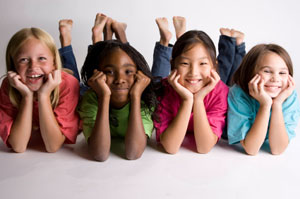
The Census taken in 2010 was the first to allow survey takers to self-identify as being in the same household with a spouse or partner of the same sex. Figure 1 shows that there were a total of 605,472 same sex couples. In comparison there were an estimated 122 million total households including 59 million married; 8 million cohabiting; 11 million single mother; 2.4 million single father; 18.5 million single females (no children or others); and 15 million single male households (no children or others) (retrieved 13 June 2014 from households take from Table H3. Households by Race and Hispanic Origin of Household Reference Person and Detailed Type: 2013 SOURCE ). The US Census Bureau also reported that there were an estimated 85 million distinct families that lived in those households (retrieved 13 June 2014 from Table FG7. Family Groups By Family Type And Sex Of Reference Person: 2013 SOURCE ).
Figure 1. 2010 US Census Count of Same-Sex Couples*
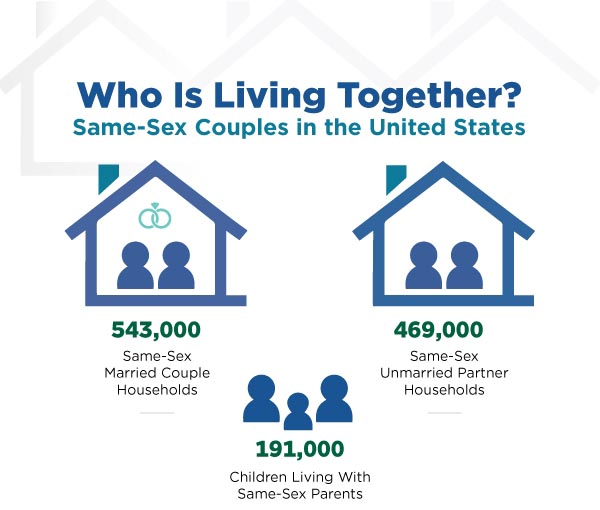 *Retrieved 13 June 2014 from http://www.census.gov/hhes/samesex/files/SScplfactsheet_final.pdf Frequently Asked Questions About Same-Sex Couple Households see also http://www.census.gov/hhes/samesex/ for other data findings Fertility and Family Statistics Branch
*Retrieved 13 June 2014 from http://www.census.gov/hhes/samesex/files/SScplfactsheet_final.pdf Frequently Asked Questions About Same-Sex Couple Households see also http://www.census.gov/hhes/samesex/ for other data findings Fertility and Family Statistics Branch
Without seeing each individual can you assign a racial category to C, E, & G below? The one drop approach is simply another version of ideological racism. Let me walk you through the Figure 2 below. To help get the point, you answer a few questions as you go. Let’s say a Black male-A marries a White female-B. Eventually they have a son-C. What is the race of this son?
Figure 2. Just Which Race Is He?
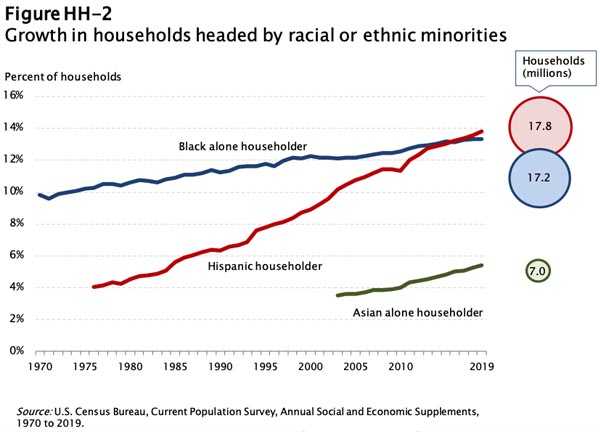 © 2019 Ron J. Hammond, Ph.D.
© 2019 Ron J. Hammond, Ph.D.
When I present that question to my students they say things like, "we need to see him to see which racial traits he has" or "that’s impossible to say because there’s no gene for race"(every so often I hear that "Black always dominates White in an interracial union). This gives us the grounds for a healthy discussion about our racial assumptions. I typically force them to vote, count hands, and even though they don’t have what they feel is needed to make the call, most will vote one way or the other and we go with the majority rule (I’m not trying to make a final judgment as much as trying to get them to think out loud about their assumptions and pre-dispositions).
I explain to them those decades ago, marrying across racial groups was considered a tainting and rendered the child non-White by default. This was true even if the child looked White with red hair, blue eyes, and fair skin. I then ask them to consider the outcome of C marrying a White female-D and they’re eventually having a son E. Again I force them to consider the racial category that E might fit into. Again they struggle. Finally, I ask them to tell me what the racial outcome is when E marries a Japanese female-F and they have a son G (This was in fact one of my 1996 student’s heritage). Children of mixed racial couples confound our ability to perpetuate the myth that race can be biologically discerned. It can’t (Google Image: Keanu Reaves, Tiger Woods, or Mariah Carey and guess their racial heritage by how they appear. Do they look like their heritage?).
Why So Much Racism?
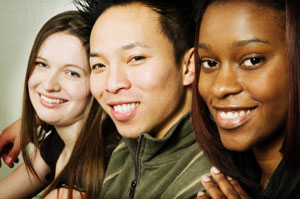
You may have already noticed that even though science has established that race is not biologically based, the US Census Bureau continues to use the racial categories when they allow survey takers to self-identify. Why? Most scientists will tell you that if people perceive something as being real then it becomes real in its consequences (Thomas Theorem). Race being based on biology is so intricately connected to all the subtle nuances of everyday life that the average person makes no distinction or effort at understanding. Most people simply believe it to be real. The Constitutional mandate to take a census of the US population so that the people are represented by Congress requires a count of people and their self-reported racial classification. Few argue that we should eliminate the race-biology construct, because it is still very important to the average person.
Coming back to the genetics question, there is no single gene that identifies if one is African American, White, Asian, Native American, or Hispanic. One Genetics company, AncestrybyDNA has created a precise test which can give you between an 80-95 percent accurate estimate of the geographic origins of your ancestors (see SOURCE) Retrieved 19 May, 2014
Oprah Winfrey, Spike Lee, and other celebrities have purchased the test (roughly about $250 and is not covered by medical insurance). After reading about Oprah’s test in a magazine, I saved my money, asked my extended family to pitch in, and bought this test for my birthday (I know I’m a real nerd). I had hoped to find out what percentage of my ancestral heritage was Native American since both my mother and father had Cherokee great-grandparents. I discovered that in fact I have no Native American ancestors. Instead I was mostly European (I have brown hair and blue eyes, and somewhat fair skin). I also had Middle-Eastern, Eastern European, and Southeast Asian ancestors.
My parents and grandparents are still confused because I have no Native American and quite a bit of Middle Eastern and South East Asian. My children felt disappointed because they defined their Native American heritage (even though it was small) as cool. A few days after I shared the results with my wife and children, my youngest son told me how cool it was to be part Asian. They came to redefine their minority heritage to potentially include Japanese, Korean, and Chinese, and that was now cool. I have since learned that the odds of children who are born to the same parents having identical ancestral genetics are very rare (only the same for identical twins, triplets, etc.). The odds of randomly getting the same genetic heritage are extremely remote. So, siblings in the same families, with the same parents have different genetic markers indicating different racially diverse heritages. In the US, we make the race-biology claim a big deal because it is part of our culture and our socialization to do so. We tend to look at 4 categories of racial traits in order to distinguish ourselves from people of other races: skin color, facial features, hair color and texture, and body shape and size (body morphology). Four simple features have been used as the categorical basis of "Us and Them" thinking patterns throughout US history. Most don’t realize that there is much more variety within a given racial category than between them.
For example, look around your classroom and pick a few students who might fall into just one of the five basic racial groupings. Observe their variations in skin tone, hair texture, color, thickness, or curl. In my classes, I’ll ask for volunteers to come down to the front of the class and stand side by side. It becomes very obvious that not all Whites (or any racial grouping of people) look alike when compared to people considered to be of the same race. Why don’t we care about variation in physical features within our own racial groups? It comes back to our culture and socialization…we are socialized to see differences between rather than within racial categories. What’s the difference between a racial and ethnic group? See Figure 4 below which is a continuum of biological versus cultural traits, race is biology-based and ethnicity is culture-based. An Ethnic Group consists of people who share a common orientation toward the world, who develop a sense of peoplehood, and who are perceived by others as having a distinctive culture.
Figure 4: Race and Ethnicity Continuum
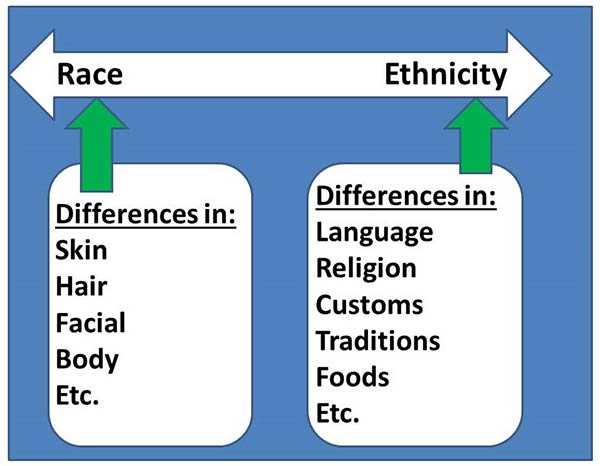 © 2009 Ron J. Hammond, Ph.D
© 2009 Ron J. Hammond, Ph.D
Ethnicity is conceptually different from race (see Max Weber’s 1922 work, reprinted in 1978, Economy and Society in Roth, G. and Wittich, C. U of Cal Press). Ethnicity refers to people, their religion, languages, traditions, and heritage. Much of what we discussed in the Culture chapter applies to one’s ethnicity as well as one’s race.
One very important US ethnic classification is Hispanic; a category that was developed by the US Census Bureau to describe people of "Latin" origin and their descendants (see description in U.S. Census Bureau Guidance on the Presentation and Comparison of Race and Hispanic Origin Data. Retrieved 19 May, 2014 from SOURCE
In 2013 the US Census reported that there were 53 million US Hispanics in 2012 with as many as 128 million living in the US by 2060 ( see Facts and Figures SOURCE retrieved 13 June 2014).
"Consequently, by the end of the period (2060), nearly one in three U.S. residents would be Hispanic, up from about one in six today. The black population is expected to increase from 41.2 million to 61.8 million over the same period. Its share of the total population would rise slightly, from 13.1 percent in 2012 to 14.7 percent in 2060" (see Press Release take from Internet 19 May, 2014 from SOURCE
Hispanic, as a categorical classification is at best an ambiguous one because there are 19 countries between Mexico and South America (including a few Spanish-speaking island nations) and 1 country in Europe-Spain that could be a nation of origin for Hispanic persons and their ancestors. By the way, Brazilians are South Americans, but their national language is Portuguese and their most common ancestral heritage is African. Are they or are they not Hispanic? Also French-speaking Haitians come from the same island nation as Spanish speaking Dominicans. Aren’t both Hispanic? "Hispanic" as a Census Bureau concept often leads to ambiguous conclusions and you’d do well to remember that the concept was created in an attempt to count US citizens with ethnic sensitivity.
To assume homogeneity, or very similar cultural traits, among all US Hispanics is a mistake. The same mistake is made when people classify all US Whites as being homogeneous. But, there is a reason that Hispanic is an important concept. Basically, it identifies a category of sub-cultures within the mainstream US population of Spanish-speaking members (albeit a very diverse collective).
Minorities and Dominant Members of Society
In US history there have been two basic groupings of citizens: Minority and Dominant. A minority group is a group living within a society that is disadvantaged in terms of power, control of their own lives, and wealth. The US minority groups were originally Native Americans and Blacks, but included Irish, Catholics, and many other non-Protestant Non-White groups. Dominant group=is the group within a social system which has more power, control, and wealth. The US dominant group was the British Protestant, also known as White Anglo Saxon Protestants, WASP. The dominant group does not always have to be the most populous group in society.
In South Africa, Blacks were by far the most numerous, yet Whites ruled cruelly with racial supremacist ideologies that led to international outcry and eventual collapse of Apartheid rule there. Apartheid was when South African formalized separateness between Blacks and Whites, mandating White supremacy and privileged treatment between 1948 and 1990. Apartheid was broken apart by the combined international efforts of other nations who put economic and political pressure on the South Africa Afrikaner National Government.
There are a number of ways the dominant group can treat its minority group members. Legislative controls include: anti-miscegenation laws (no inter-racial marriages); forced or reinforced segregation (keeping dominant and minority group communities separate); legal oppression (slavery, denial of right to vote, no public education, etc.); Expulsion (Cherokee Trail of Tears forced march), unjust incarceration (WWII Japanese internment camps, Native American pre-reservation incarceration, and Guantanamo Bay-GITMO); and finally out right annihilation (conquering Native Americans).
Another slightly more subtle treatment is called Marginalization is the purposeful mistreatment of minority group members that yields them geographically part of the society while simultaneously being functionally left out of most of its opportunities. Marginalization often results in material deprivation and exclusion. Most non-Anglo Saxon groups experienced some level of marginalization in US history.
After years, decades, and generations of living under dominant group oppression, minority group members often reach a point of standing up against the dominant group. This happened among the pro-French minority group members in Quebec, Canada; among the Blacks in South Africa; and among the Blacks in the Southern United States (like Rosa Parks). Many minority group members accept their plight and live with social circumstances regardless of how they really feel inside. Because of their frustration and long-term fatigue they sometimes self-incriminate and accuse self, family, friends, or others in their minority group of negative stereotypes and labels imposed by the dominant group.
Sometimes, minority group members rise up in defiance and become agents of social change. This was the case with the Reverend Dr. Martin Luther King Jr. (1929-1968, see photos below). He has been a personal hero of mine for many decades. You see I, too was born in Atlanta, Georgia in 1963. I was privileged to witness the transition years in the South where Blacks were once oppressed by the older generation that included my parents and grandparents and have experienced more and more equality than ever before (there’s still much change to take place and I hope it will happen in my lifetime). As a child my parents forced me to drink from White-only water fountains, my teachers forced me to sit in front of Black students (in classrooms and busses). My coaches forced me to bond to high school teammates, while simultaneously discouraging any after-school interactions with non-Whites. None of that felt right to me and my friends. We felt confused about why our innocent friendships were so tightly regulated by the adults around us.
In my Junior year in high school (about 1980) the KKK distributed flyers announcing a huge rally in downtown Douglassville, Georgia. The best word I could find to describe to you our feelings as students at Lithia Springs High School was confusion. Their anger and hate did not make sense to us. Friendships and associations were laden by an uninvited awkwardness that sat like smog in the classrooms and hallways. The big day of the rally came, the local and national media showed up, but as I remember it only about 12 participants came to the rally and they were already affiliated with the KKK. Day-to-day functioning eventually returned to our school, yet we learned a lesson that adults could be stupid at times and we had to watch and protect ourselves around them. So, perhaps you can better see why Martin Luther King Jr. is my hero?
Martin Luther King’s life and accomplishments were remarkable even before he became the most influential civil rights change agent in the United States. He graduated with a Bachelor’s degree in Sociology in 1948. He earned another Bachelor’s degree in Divinity in 1951, then his Ph.D. in Systematic Theology in 1955. He became a pastor in 1954 at the age of 25 (see http://www.thekingcenter.org ). He had a unique ability to ignite a passion for unity among all people, even the White dominant group. He took a Functional approach (as opposed to the more common Conflict approach). In Table 2, you can read how he utilized his principles of Non-violent resistance to evil. These core principles guide civil rights efforts in our day:
Table 2. Martin Luther King Jr’s Principles of Non-Violent Resistance
- We should all be active in using non violent resistance to evil (racism)
- We should not seek to defeat our enemy but to win his friendship and understanding
- We should focus on attacking evil rather than those doing the evil
- We should be willing to accept suffering as part of the social change process and not retaliate for it
- We should refuse to hate our opponents
- We should act with a firm hope that justice will prevail
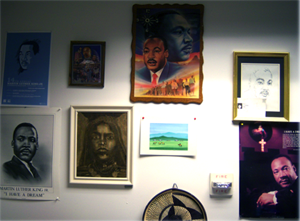
This photo is of the East wall of my office on campus. My collection of Martin Luther King, Jr. posters, paintings, clocks, and quotes is important to me and often impresses students enough that they ask me why I have such a collection. That opens the door for me to talk about his concepts, speeches, sermons, efforts, and leadership. Students and faculty have contributed some of my collection after they understand my respect for Dr. King. Many signatures are on the backs of these, including the late Yolanda King who signed a postcard for me when she spoke on our campus. On the gold-framed drawing above, you’ll notice a postcard stuffed in its lower left side of the frame. That’s an autographed card given to me by Yolonda (she passed away 15, May 2007).
Prejudice and Discrimination
One of the mighty principles taught by Martin Luther King Jr. was hope for a positive and mutually beneficial outcome. He urged those who followed his example to see evil for what it was, yet hope for things to end on the side of good. In this next section of discussion we will talk about how to build bridges between racial, ethnic, lifestyle, cultural and other diverse groups of people. To do that, we must define the difference in prejudice and discrimination.
Prejudice is attitudinal. Discrimination is behavioral. Prejudice may be a feeling, thought, or even a predisposition towards others. Discrimination may be speech, mistreatment, illegal or legal, and behavioral (our actions). A modern-day Psychologist named Gordon W. Allport (1897-1967) wrote a profound piece called The Nature of Prejudice (1979, Perseus Books). You can now buy the 25th edition for less than $20.00 online. Yes, it’s been around that long and has made a tremendous impact on students and faculty for many years. In his book he classifies prejudice into three broad levels: Cognitive Level of Prejudice refers to our perceptions and beliefs and is based on logical and rational thoughts; Emotional Level of Prejudice refers to prejudiced feelings which are aroused by expression or thoughts; Action-Orientation Level of Prejudice is a predisposition to act in favor of or against certain groups.
At the cognitive level prejudice, thoughts are the vehicle for carrying the prejudice. Stereotypes go hand in hand with this level. Stereotypes are broad generalizations about a category of people who are assumed to have positive and negative traits common to every single member of that category. I’ve taught race and minority relations for about 20 years at the college level. Many of my students will sincerely ask me if a certain racial or ethnic group is: "more likely to be drunk, more likely to be violent, built with genetically superior muscles and tendons, are good at math, have a gene for dancing, or are built to make babies." Inevitably, I’ll get around to asking them where they heard such notions and typically it came from someone they trusted (teachers, coaches, family, friends). Thoughts can be painful to those victimized by this type of prejudice.
Shortly after the terrorist attacks on the US in September 11, 2001 (9-11), our young children were trying to sell our pedigreed toy poodles. The sales were slow in coming because of the economic state of things. The typical client who purchased them was middle class, wealthy and interested in companionship more than making a profit (most had them spayed or neutered). We posted flyers on community billboards and sold all but one (which eventually was donated to an older couple). One day, I walked past our flyer only to discover that it had been written on (see photo below). "White Trash Breeder…7 million unwanted animals killed every year shame on you," it read. This is an example of cognitive prejudice. It is also an act of discrimination because the person wrote (acted) on their prejudiced feelings. I’ll explain more about this below.
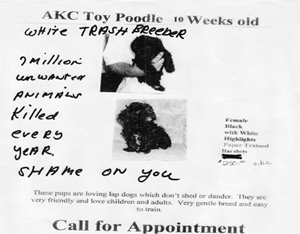
Emotional prejudice includes our feelings, fears, hopes, joys, jealousies, and other emotions. The concept of relative deprivation applies and often underlies emotional based prejudices. Relative Deprivation is the perception of not being the rightful beneficiary of something a person feels entitled to receive. I once had a student try to explain to me why his father couldn’t get good work because of immigrants who would be willing to bid jobs at lower cost to the builders and often win the bid. As I discussed it with him I learned that his father’s price per hour was very high by most standards. I also learned that his father typically worked 40-60 hours per week and was off only when he took vacations. I also learned that he had felt fear once at a football game when he was confronted by people who looked and talked like the immigrants that were the cause of his feeling of being deprived. He was very discontent, yet really had no reason to be. His father’s mealtime anti-immigration discussions had left him feeling that perhaps his own food was being taken from their table by the immigrant laborers.
Once a person feels relative deprivation, then choose to become the victim, they make those who are the focus of their deprivation (the perceived cause) into perpetrators. This in turn justifies their prejudice and at times their discrimination against others. In general, emotional prejudice can be very dangerous because when we are emotional, we are typically feeling rather than using our complex rational thinking processes. Sometimes individuals, mobs, and hostile groups act dangerous when emotional prejudice is felt.
Allport’s action-orientation levels simply mean that people are predisposed to prejudice and may not know it until circumstances present themselves in such a way that their prejudices emerge. I had a dear friend who died from cancer a few years ago. She was and to this day has been my best friend on campus. She and her husband had children my age and they considered me as a younger friend like unto their children. When their youngest son met a Japanese-Korean young lady and fell in love, he brought her home to meet them. She explained to me that she and her husband were very troubled and realized that in their generation people just didn’t marry across racial and ethnic lines. After long discussions with one another and their children, they apologized to their daughter-in-law to be and were forgiven by her for their prejudices. Years after the wedding and the arrival of their new grandson, she expressed to me the joy and love she felt for her daughter-in-law and how she felt like she was truly as close to her as she was to her own daughter.
I received a call, later from her husband, informing me that she had died suddenly. He asked me to speak at her funeral alongside her sons. At the viewing, I noticed the daughter-in-law, quietly crying in the corner of the room. It was her individual way to grieve alone. I intruded on the moment and visited with her. Because I had shared an office with her mother-in-law, I was able to communicate some of my friend’s thoughts and feelings toward her. This helped her to grieve and feel peace at her time of loss. I later reflected on how courageous and humble my friend and her husband were to take ownership of their prejudices, admit wrong, and work toward managing it by loving and supporting their son and daughter-in-law. It was a win-win outcome.
How Can We Overcome Prejudice?
You may have already wondered, what are the differences in prejudice, stereotypes, and my own personal preferences? I had a student ask me, "If I don’t like Chinese food, does that make me prejudiced?" I think this was a sincere question. I explained that it does not make her prejudiced to simply prefer one food over another, one genre of film over another, or one style of car over another. See the Figure 5 below.
Figure 5. The Difference Between Personal Preferences, Prejudices, and Stereotypes.
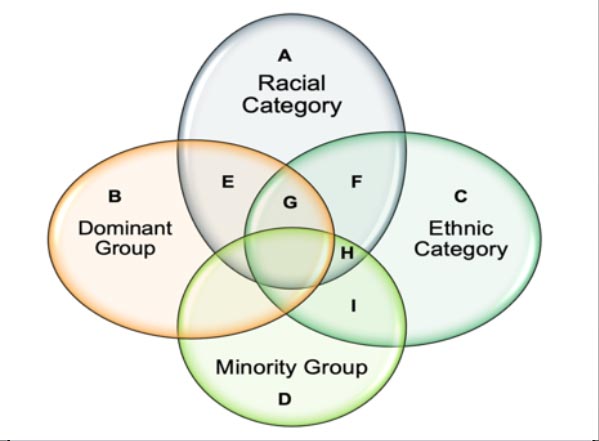 © 2009 Ron J. Hammond, Ph.D.
© 2009 Ron J. Hammond, Ph.D.
The best way to understand prejudiced thinking is to understand the concept of categorical thinking. Categorical Thinking is the human cognitive process of storing and retrieving information in sections of our memory that are highly associated with one another. For example, read this list: awake, dream, snore, bed, eat, slumber, sound, wake, and night.
Now pick the single best word that categorically fits into this list: computer, wheel, or sleep. Most of my students pick sleep because it so highly related to the original list of concepts. The point is, we think in associations and categories. That’s why if you get wheeled into an emergency room with a fever, pain and one side of the abdomen, perspiration, and nausea that suddenly hit, doctors suspect Appendicitis. Categorical thinking saves lives, helps you to pass tests, and keeps students employed when their bosses see them as good employees. It is true that categorical thinking makes it so we can function, but it also is the thinking process that underlies prejudice and stereotypes in our relationships. The key is to control categorical thinking, prejudices, and stereotypes.
First, you have to do some self-analysis and discover where you might have learned your prejudices. Many people are taught prejudice from: family, friends, teachers, religious leaders, television, internet, and other agents and agencies of socialization. It’s feels strange to think that family might teach other family members to be prejudiced, but this may be one of the more common sources. In the 1949 musical, South Pacific, Richard Rodgers and Oscar Hammerstein II, wrote a gutsy song called "You’ve Got To Be Carefully Taught…to hate and fear, to be afraid…and to hate all the people your relatives hate." (to see the entire lyrics to the song go to SOURCE ) Retrieved 19 May, 2014. Or from SOURCE ).
For the year 1949, this was in truth a very gutsy song that proved to be way ahead of its time. Yet, it impacted a great many people who watched the movie. Without knowing that science would someday prove these lyrics to be true as a far as how children do come to be prejudiced, Rodgers and Hammerstein were years in front of the Civil Rights movement in the US. Socialization of Prejudice is learning prejudice from people we look up to (family, relatives, teachers, etc...).
Another source of our prejudices is the social structural source. Social Structure Origin of Prejudice occurs when prejudice is built into the group, community, and social institutional components of society. This was the case in public education when Blacks and Whites were segregated in their churches, schools, workplaces, and other agency-level social environments. Few questioned it because it appeared to be part of the world-taken-for-granted.
There is also, the Competition Origin of Prejudice occurs when members of one group feel threatened and or deprived by members of another group for limited resources. This ties in well with the concept of relative deprivation. When groups of people feel that they are losing at the expense of other groups’ gains; it breeds and fuels competitive hostility at numerous levels. I often teach my students to remember as managers not to create competitions in the workplace among their employees. Create competition between companies or factories, but if competition is fostered between group members, it can easily lead to prejudice and hostility.
Interdependence is the dependence on others for support in order to be able to succeed. This principle works just the opposite of competition (see the "Jigsaw Method" at SOURCE ). One can create a non-prejudiced environment by creating mutual dependence among individuals who are vested in the success of themselves and their group—if the individual’s success depends upon the group’s success. Prejudices can also originate from negative interactions with members of a certain group that are distorted overtime and become applied to the category of all group members.
Once you get an idea of where your own prejudices came from you can employ proven strategies for managing them. First and foremost, you are the only one who can manage your personal prejudices. The same is true for me. I have been frustrated for decades trying to help my own socially significant others to see the wisdom that comes with refusing to be prejudiced. For the most part, I have failed in my attempts with them. Ultimately, it boils down to an old joke (not sure who came up with it):
"How many therapists does it take to change a light bulb? It only takes one, but the bulb has to really want to be changed" ☺ (I never claimed it to be a funny joke). But, the point is people change their ways when they are ready to change their ways. I’m glad I tried to help with that change, but have only succeeded thus far in managing my own prejudices. Here are a few principles that may be very useful if you are trying to manage prejudices and stereotypes.
First, interact with others on the personal, not the categorical level. Martin Luther King Jr. said:
"I say to you today, my friends, so even though we face the difficulties of today and tomorrow, I still have a dream. It is a dream deeply rooted in the American dream."
I have a dream that one day this nation will rise up and live out the true meaning of its creed: "We hold these truths to be self-evident: that all men are created equal."
I have a dream that one day on the red hills of Georgia the sons of former slaves and the sons of former slave owners will be able to sit down together at the table of brotherhood.
I have a dream that one day even the state of Mississippi, a state sweltering with the heat of injustice, sweltering with the heat of oppression, will be transformed into an oasis of freedom and justice.
I have a dream that my four little children will one day live in a nation where they will not be judged by the color of their skin but by the content of their character"Retrieved 12 June, 2008 from SOURCE ).
His point toward the end, about his four little children living in a nation where "they will not be judged by the color of their skin but by the content of their character" is speaking to the fact that to really judge character you must interact personally, not categorically (color of their skin). The safest and most proven way to interact with another at the personal level is to share trusted feelings and thoughts with others while simultaneously have similar thoughts and feelings be shared back with you. You might replace "the, they, theirs," or the labels we use such as Black, Whites, etc. with you, me, I, my, or the name of the individual. The personal level quiets the categorical thinking process. You can’t use stereotypes if you are genuinely getting to know and trust another person. Scarcely does a day go by that I am not proud of the US 2008 national Presidential election. In it we had a woman, Black man, and 2 traditional White men on the Presidential and Vic-Presidential tickets.
Now, regardless of who you wanted to win or may have voted for, to some of us old folks born in the 1960s there is a deep sense of joy that the country finally followed Dr. King’s counsel to judge a candidate on his or her character. President Obama symbolically represents the death of old school US ideological racism and has lifted our nation’s standing among many nations of the world which have traditionally elected qualified people regardless of race, color, sex, creed, lifestyles, etc.
Second, find the common ground shared between you and others. Ask questions, share information and look for the experiences, exact or similar, that connect you both on common shared backgrounds. Third, if you say or do something offensive to another, talk about it and apologize. Learn from your mistakes. One prejudiced thought or feeling does not a bigot make. Fourth, find someone you can relate to who has managed their prejudices successfully, then let them be a role model.
Fifth, take a cue from a gifted expert in the field. During the celebration of Brown V. Board of Education and the movement toward desegregation in US public Schools a TV News Show interviewed some experts who had been witness to the US Supreme Court decision and had worked in the field all these years. The news anchor, Gwen Ifill asked a question of Cheryl Brown Henderson, "Cheryl Brown Henderson, since your life span and your — your arc of your life has traced Brown v. Board, I want to know whether, on the 60th anniversary, you find yourself optimistic or pessimistic about where we are now." Part of Cheryl’s response had a potent piece of expert advice that emerged almost unnoticed in the panel interview. She said,
"What we didn’t do that I would love to see us do in terms of being optimistic was to have some sort of reconciliation. I look at Nelson Mandela and what happened in South Africa. It was amazing. But where’s the courage here to have that kind of reconciliation panel and that real dialogue? After Brown v. Board, we missed a huge opportunity, I think. I taught school in the ’70s. And I taught at one of the schools that had been segregated, where my mother had gone, where my sisters had gone. And then their kids had gone there post-Brown and I taught there post-Brown"(retrieved 13 June 2014 from SOURCE Original news panel interview called, "60 Years after Brown v. Board, school segregation isn’t American History" Brown v. Board original decision 17 may 1954. Note Cheryl Brown Henderson is the daughter of Oliver L. Brown see more at SOURCE ).
Perhaps, using all the strategies listed above could lead up to an effort at honest reconciliation which could prove to help old wounds heal and children and grandchildren of the original participants see an example of working things out and moving on together. Reconciliation efforts have been pursued after bitter and deadly wars (for example between the US and Vietnam & Germany and other European Nations). It is much easier to simply assume the role of victim; count the number of prejudiced0-based offenses and crimes; and avoid any honest conversation between parties involved. But as the Reverend Dr. Martin Luther King Jr. explained: "we should all be active in using nonviolent resistance to evil (racism), not seeking to defeat our enemy but to win his friendship and understanding; attacking evil rather than those doing the evil; willing to accept suffering as part of the social change process and not retaliate for it; refusing to hate our opponents; and finally acting with a firm hope that justice will prevail." Attempting to reconcile would require such tenants if it were to succeed.
Perhaps the most striking effort on the part of any nation to help its people reconcile transpired in 1994 with hundreds of thousands of Tutsi ethnic minorities being hacked, shot, stabbed, bludgeoned, raped, and murdered by the majority ethnic group comprised of Hutus. After military intervention, incarceration of most of the actors who participated in the killings, the new Rwandan President ordered everyone to forgive one another. For some, reconciliation transpired. For others, it did not work. For many experts in the field the attempt itself was remarkable and provided a case study of grief and healing at the personal, inter-group, and larger social level from which many could learn a valuable lesson.
Documentaries on the effort to reconcile in Rwanda:
2 April 2014 National Geographic "Rwanda Genocide: In Rwanda, Reconciliation is Hard Won." SOURCE
PBS "Rwandan Reconciliation" 17 April 2009 SOURCE
PBS 28 May 2014 "Healing Wounds of Rwanda’s Genocide Through Reconciliation" SOURCE
AlJazeera TV "Rwanda Genocide survivors back reconciliation" 5 April 2014 SOURCE
DW Journal reporter 4 April 2014 "20 Years After the Rwandan Genocide: Searching for Reconciliation" SOURCE
One final point of importance—we discussed discrimination above, but it needs to be revisited here. Discrimination includes behaviors that result in the unfair or unequal treatment of others. Discrimination is an action (not just a feeling or thought) that typically has two forms: De Jure Discrimination is legalized discrimination that is typically built into the social structure; and De Facto Discrimination is the actual experience of members of society with discrimination.
Even though discrimination is illegal, it still occurs in the US. People, at times, still aren’t served in restaurants, allowed to lodge in motels, or are refused employment. Not all discrimination can be detected much less punished. In the US history of race relations tremendous injustices have been meted out against minority group members by dominant group members and organizations. Most of these will never see justice for their losses.
There are those who discriminate and are not prejudice and those who don’t discriminate who are prejudiced. How can this be? Look at Robert Merton’s 2 x 2 matrix below in Figure 6. Merton identified four types of people: an All-Weather Liberal is neither prejudiced nor does he/she discriminate. These people tend to be very educated, non-traditional, and open-minded individuals who fail to remember that others rarely feel the same way they do. A Fair-Weather Liberal is not prejudiced but does discriminate. These people tend to be those who go along with the crowd or obey orders. They may feel guilty because they act under pressure in contrast to their inner values. Timid Bigots are prejudiced but won’t discriminate.
Figure 6. Robert Merton’s Prejudice & Discrimination Typology*
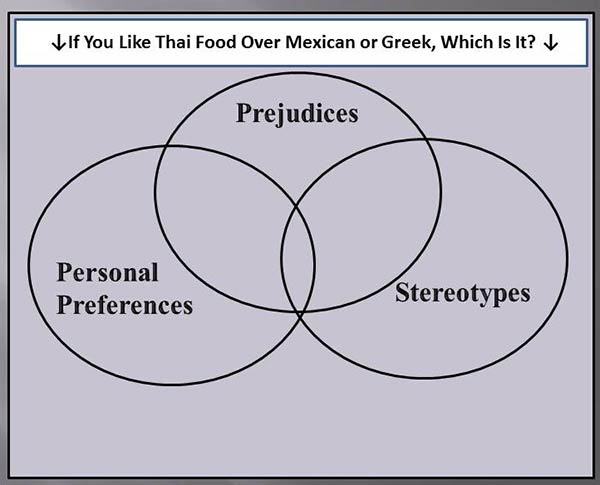 * (See original Chapter: Merton, R. K. 1949, "Discrimination and the American Creed," in Discrimination and National Welfare, edited by Maclver, R. M. Harper Pub. NY pages 77-145).
* (See original Chapter: Merton, R. K. 1949, "Discrimination and the American Creed," in Discrimination and National Welfare, edited by Maclver, R. M. Harper Pub. NY pages 77-145).
These people tend to be afraid of acting on their prejudices, not wanting be caught or punished. Active Bigots are both prejudiced and they discriminate. These people tend to be extremely disconnected to mainstream values and harbor a profound sense of entitlement in regards to acting as they desire regardless of the laws, norms, and morals of society.
One extreme form of discrimination is the hate crime. Hate Crimes are perpetrated by individuals who attack others based on their own intense feelings of bias and bigotry. The FBI estimates that fewer than 10,000 Hate Crimes occur each year in the US. But this is highly deceptive because most hate crimes are not reported and are not required to be reported as in the case of all other crimes in the FBI Uniform Crime Report (see Beirich 2007 Taken form Internet 10 June 2008 from SOURCE)
Two FBI researchers, John R. Schafer and Joe Navarro discussed the hate process for individuals and groups; they published a ground-breaking report on understanding hate and those who criminally perpetrate it (Retrieved 19 May, 2014 from SOURCE )
They referenced three types of hate crime perpetrators: Thrill Seekers tends to commit hate crimes with peer group members but does not belong to hate group; Hard-Core Offenders are extremely violent and aggressive (typically a Hate Group Member); Reactive Offenders ground their attack on a perceived transgression, such as an insult, interracial dating, or a neighborhood integration.
Many hate crime perpetrators are not members of hate groups. They tend to be young, white, from poorer families, and have very weak self-concepts. Their hate crimes are the result of their compensating for their insecurities by making victims out of others (see "Why Do Young Men Commit Hate Crimes?" NPR News and Notes 23 June 2006 from SOURCE
Also, many of these perpetrators utilize secondary justification where they try before, during, and after the assault to prove to themselves and others that they were the victims and not the perpetrators. They lie to police, they react to negative coverage in the media as being an act of aggression, and they self-deceive in terms of what an offense is. For example, when they are out about town they feel that they have been violated to have to see in public an interracial or same sex couple or immigrant.
They tell the police, "they started it." In fact nothing was started outside the minds of the perpetrators. Many seek out and cruise for potential victims in places they are likely to hang out. The most common form of hate Crime is the: Racial bias, Religious bias, Sexual-orientation bias, Ethnicity/nation origin bias, and Disability bias (see table at FBI.gov retrieved from Internet 21 May, 2014 from SOURCE ).
When reporting on the 2012 incidence of hate crimes in the US, the FBI report stated that 48.5 percent were racially-based hate crimes; 19.2 percent were sexual-orientation-based; 18.7 percent were religious-based; 12.1 percent were ethnicity-based; and 1.2 percent were based on a person having a disability (retrieved 13 June 2014 from Uniform Crime Reports: Hate Crime Statistics, 2012 found at http://www.fbi.gov/about-us/cjis/ucr/hate-crime/2012/topic-pages/victims/victims_final.pdf ). Remember, all of these hate crimes were based on the offender’s biases toward or against certain types of people.
------
This has been an overview of race and ethnic relations. Please keep reading course material for a more detailed perspective!